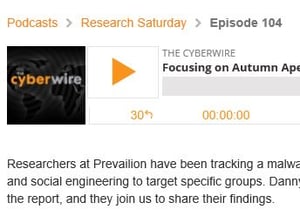 Using some very sophisticated methods, the Kimsuky group is believed to be behind a spear phishing campaign aimed at stealing U.S. secrets.
Using some very sophisticated methods, the Kimsuky group is believed to be behind a spear phishing campaign aimed at stealing U.S. secrets.
This attack, dubbed “Autumn Aperture” by cybersecurity compromise management firm Prevailion, is a great example of just how much diligence and effort a cybercriminal group will exert in order to ensure their success.
In this string of attacks, not only were U.S. firms targeted, but specific individuals and their work details were also gathered to establish context for spear phishing attacks aimed at compromising endpoints. For example, one target was sent a copy of his speaker’s notes for a presentation recently given. The notes were a legitimate document requiring macros to be enabled to be viewed in order to launch the malicious code lying within the document. In many cases, similar levels of contextual detail were used in order to make the phishing attacks very personal.
On the malware side, the malicious code was even designed to call Windows Management Instrumentation (WMI) on the endpoint inquiring about all running processes in order to identify security solutions that would detect a downloaded payload.
This level of detail put into both the phishing attacks and the malware demonstrate the level that attackers will go to should they really want to gain entrance to your network.
Organizations concerned about any kind of phising attack should be educating users with Security Awareness Training in an effort to elevate their understanding about the potential risk in opening attachments and clicking links. This training helps users become savvy about phishing scams, social engineering, etc. so that when (not if) they come in contact with a phishing email, it will be spotted immediately and discarded rather than clicked on.
The CyberWire has the PodCast: https://thecyberwire.com/podcasts/cw-podcasts-rs-2019-09-28.html
 Here's how it works:
Here's how it works:




